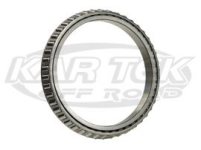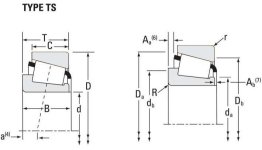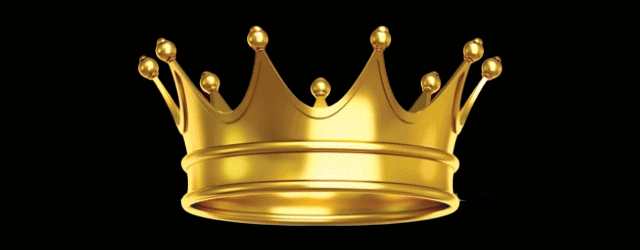Breaking this out from the cv bolt thread. Original post:
Just an FYI update. I have recently had to replace the wheel bearings in my Gray Area 934 mids. They have now gone to a Koyo bearing and spec 65lbft for the 1/2" cv bolts with red loctite. You will need to either send the bearing plate or the complete hub in to GA for modification and maintenance. If you have a lathe you can do the easy mod yourself.
I had to replace the wheel bearings due to the fact that the hub was originally assembled ,direct from GA ,without the inner seal and the results was washed out wheel bearing grease killing the wheel bearings. One of the few times I haven't disassembled/inspected something before running. GA was good to deal with but they also basically ignored the fact they were the cause of my needing to spend $$$$ for their mistake. They gave me a small discount but would not even consider providing the missing seal(I didn't even ask for anything on the bearings at that point even though it was their fault for the failure).. I'm not very happy to say the least. It is what it is in the aftermarket though.
New update and questions:
OK,it has come time for both hubs to be serviced . I am totally confused on what the hell the reason was for a mod to the hub and a bearing spacer. As posted above, I had to replace hub bearings (driver side)due to the hub missing the inner seal from the factory. I was told the replacement Koyo bearing would assemble slightly thinner and would need the spacer ,supplied by GA,to get preload right. Fine,I was good with that.
Now I have both hubs apart and I find that the Koyo bearings in the drivers hub and the original(whatever brand) are the same exact width as would be correct for Timken and Koyo. Since there are no markings on the original (passenger side) bearings I would have to assume they are the ones GA had made in India . Bottom line is why did I have to do a mod to the hub and use a spacer with the Koyo bearings since apparently all 3 bearings are of the same spec width? Were the China bearings wider?
I do not recall what the mod was now. Regardless, all the hub components dimensions are the same side to side and the bearing widths are the same yet I have a approx. .050" spacer on one side. Something is not right. I either have one side with way too much preload or one side too loose. When new both hubs took about a 4 foot bar to be able to turn them with a lot of effort. In all honesty that seemed way the hell too much but was told they would loosen up. Well they did apparently as the passenger (no spacer behind the bearing)side bearing has worn a groove maybe .025 deep in the hub. That side did develop a barely noticeable bit of camber.
I am a bit mystified how the hubs can be identical now that I did whatever mod was done. I honestly do not remember what mod was or if the spacer was all there was to it now. Damn it sucks to get old and forgetful.......... LOL! Either way,something is not right.
Bottom line now is how much preload should there be? I would think something along the line of wheel bearing would be much more appropriate. Why would they need/want to be so tight? Am I wrong? I need to do some machine work and make some appropriate spacers to bring these hubs back to new condition. Any opinions on what sort of torque should be needed to indicate proper preload? I know new bearings would be a bit tighter than reused bearings.
Thanks for any insight.
Just an FYI update. I have recently had to replace the wheel bearings in my Gray Area 934 mids. They have now gone to a Koyo bearing and spec 65lbft for the 1/2" cv bolts with red loctite. You will need to either send the bearing plate or the complete hub in to GA for modification and maintenance. If you have a lathe you can do the easy mod yourself.
I had to replace the wheel bearings due to the fact that the hub was originally assembled ,direct from GA ,without the inner seal and the results was washed out wheel bearing grease killing the wheel bearings. One of the few times I haven't disassembled/inspected something before running. GA was good to deal with but they also basically ignored the fact they were the cause of my needing to spend $$$$ for their mistake. They gave me a small discount but would not even consider providing the missing seal(I didn't even ask for anything on the bearings at that point even though it was their fault for the failure).. I'm not very happy to say the least. It is what it is in the aftermarket though.
New update and questions:
OK,it has come time for both hubs to be serviced . I am totally confused on what the hell the reason was for a mod to the hub and a bearing spacer. As posted above, I had to replace hub bearings (driver side)due to the hub missing the inner seal from the factory. I was told the replacement Koyo bearing would assemble slightly thinner and would need the spacer ,supplied by GA,to get preload right. Fine,I was good with that.
Now I have both hubs apart and I find that the Koyo bearings in the drivers hub and the original(whatever brand) are the same exact width as would be correct for Timken and Koyo. Since there are no markings on the original (passenger side) bearings I would have to assume they are the ones GA had made in India . Bottom line is why did I have to do a mod to the hub and use a spacer with the Koyo bearings since apparently all 3 bearings are of the same spec width? Were the China bearings wider?
I do not recall what the mod was now. Regardless, all the hub components dimensions are the same side to side and the bearing widths are the same yet I have a approx. .050" spacer on one side. Something is not right. I either have one side with way too much preload or one side too loose. When new both hubs took about a 4 foot bar to be able to turn them with a lot of effort. In all honesty that seemed way the hell too much but was told they would loosen up. Well they did apparently as the passenger (no spacer behind the bearing)side bearing has worn a groove maybe .025 deep in the hub. That side did develop a barely noticeable bit of camber.
I am a bit mystified how the hubs can be identical now that I did whatever mod was done. I honestly do not remember what mod was or if the spacer was all there was to it now. Damn it sucks to get old and forgetful.......... LOL! Either way,something is not right.
Bottom line now is how much preload should there be? I would think something along the line of wheel bearing would be much more appropriate. Why would they need/want to be so tight? Am I wrong? I need to do some machine work and make some appropriate spacers to bring these hubs back to new condition. Any opinions on what sort of torque should be needed to indicate proper preload? I know new bearings would be a bit tighter than reused bearings.
Thanks for any insight.



